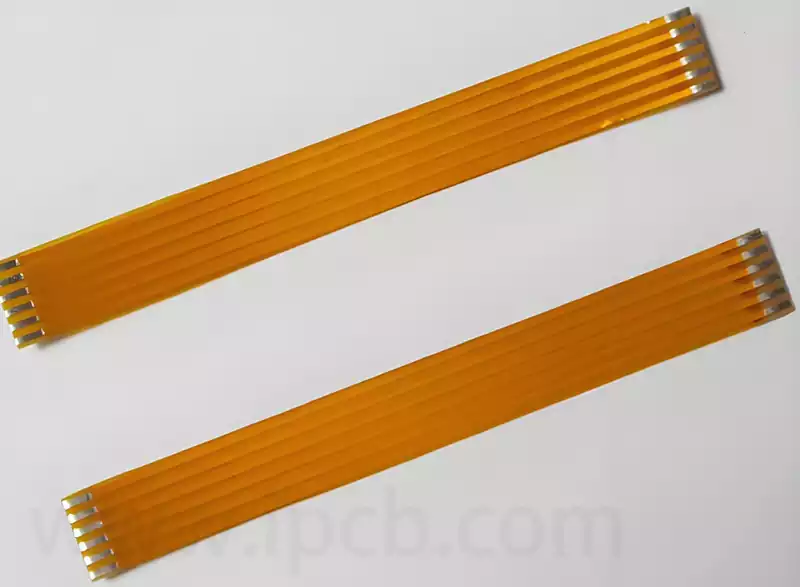FPC cable is made of polyimide or polyester film as a substrate with a high degree of reliability, excellent flexible printed circuit board. This circuit board can be bent at will, folding light weight, small size, good heat dissipation, easy to install, breaking the traditional interconnection technology. In the structure of the flexible circuit, the constituent materials are are insulating film, conductor and adhesive.
FPC cable consists of several layers, including substrate (such as polyimide), conductive copper foil, cover film, etc. FPC usually has high mechanical strength and thermal stability, suitable for complex circuits and multi-layer design.
Structural characteristics: FPC cable is a flexible printed circuit board, mainly composed of flexible substrate and copper foil, with the advantages of good bending and light weight.
Connection: FPC cable can be connected by welding or crimping, usually designed for fixed connection inside the equipment, suitable for space-constrained occasions.
Application: FPC cable is widely used in mobile phones, tablet PCs, cameras and other portable electronic products, such as keyboard cable, camera cable and so on.

FFC Flexible Flat Cable (FFC) is a new type of data cable made of PET insulating material and extremely thin tinned flat copper wire, pressed together by high-tech automated equipment production line, which has the advantages of softness, arbitrary bending and folding, thin thickness, small size, simple connection, easy disassembly, easy to solve the electromagnetic shielding (EMI). Currently widely used in a variety of printers print head and the connection between the motherboard, plotters, scanners, copiers, audio, LCD appliances, fax machines, various video disc players and other products signal transmission and board connection. It is almost ubiquitous in modern electrical equipment.
Types of FFC connectors
According to the design and application requirements, FFC connectors can be divided into various types, mainly including:
Inline FFC connectors: Suitable for connections directly into the board, mounted by surface mount technology (SMT), with a compact form factor and low-profile design.
Socket FFC connectors: Suitable for use in conjunction with pins or other connectors to provide a convenient way of plugging and unplugging to facilitate the replacement, debugging or repair of electronic devices.
Spring-loaded FFC connectors: Utilising a spring-loaded tab as the contact portion of the receptacle, the flat flexible cable strip is secured and connected by pressure to maintain a stable electrical connection in vibrating environments.
In addition to the above types, there are other forms and designs of FFC connectors that exist according to different application requirements, such as special angle FFC connectors and locking FFC connectors.
Structural components of FFC
FFC (Flat Flexible Cable) is mainly composed of the following key components, each of which directly affects its performance and usage scenarios:
1. Wires
Function: Flat, electrically conductive pathways responsible for transmitting electrical signals between connected devices.
Characteristics: usually made of tinned copper, arranged in parallel, covered with insulating materials
2. Pins
Function: Conductive contacts located at both ends of the FFC, used to connect with the corresponding pins of another device.
Characteristics: A-type FFC: both ends of the pin on the same side
D-type FFC: two pins on the opposite side (mirror arrangement)
3. Pitch
Definition: The distance between the centre lines of two adjacent wires.
Common specifications: 0.5mm, 1.0mm, 1.25mm, etc.
Impact: the pitch determines the compatibility of the FFC and the connector, need to match strictly
4. Reinforcement tape (Support Tape)
Function: Reinforce both ends of the FFC to make it easier to insert into the connector without bending or damage.
Material: usually polyimide (PI) or PET tape.
Function: Enhance the durability of insertion and removal, especially suitable for high frequency insertion and removal scenarios.
FFC vs FPC cable Difference:
Structural differences: FFC cable is more flexible and flat, suitable for frequent bending occasions; while FPC cable is a flexible printed circuit board, more suitable for fixed connection inside the device.
Connection: FFC cable is often connected with socket, suitable for frequent plugging and unplugging; FPC cable is usually soldered or crimped fixed connection, suitable for space constraints and long-term stability of the connection occasions.
Application areas: FFC cable is mostly used in household appliances, digital products and other occasions; FPC cable is mostly used in portable electronic products, such as mobile phones, tablet PCs and so on.
When FPC is only used to achieve a simple connection function, and does not involve complex circuit modules or high-speed signal transmission, FFC becomes a reasonable and economical alternative.
Simple point-to-point connections, such as between two circuit boards, where FFCs can provide a stable and reliable connection.
Low-speed signal transmission applications, such as keyboards, displays, and other devices that have no special requirements for high-speed signals.
Cost-sensitive scenarios, such as printers, household appliances and other products that require strict cost control.
Static connection occasions, the internal connection of the device is fixed and does not require frequent bending.
The advantages of FFC are mainly:
Significant cost-effectiveness, due to its simple manufacturing process and low material costs, very suitable for mass production.
Convenient installation, with standardised design, easy plugging and unplugging operation, meeting the needs of rapid assembly and maintenance.
Simple structural design, regular wire arrangement, easy to design and use.
However, the following points should be noted when using FFC:
The bending radius should be reasonably designed to avoid wire breakage, and it is usually recommended that the bending radius is not less than ten times the thickness of FFC itself.
Mechanical protection should be done well to avoid excessive mechanical stress and wear and tear during installation or use to ensure the reliability of use.
Electrical performance, although suitable for low-speed signal transmission, but in the high-speed signal transmission requirements are high, its performance is not as good as FPC, should be carefully selected according to specific needs.
FFC and FPC cable as two mainstream flexible connection technology, each with its own characteristics and adapt to different application requirements. Reasonable choice of FFC or FPC can not only ensure the stability and reliability of electronic equipment, but also effectively control costs and improve production efficiency.